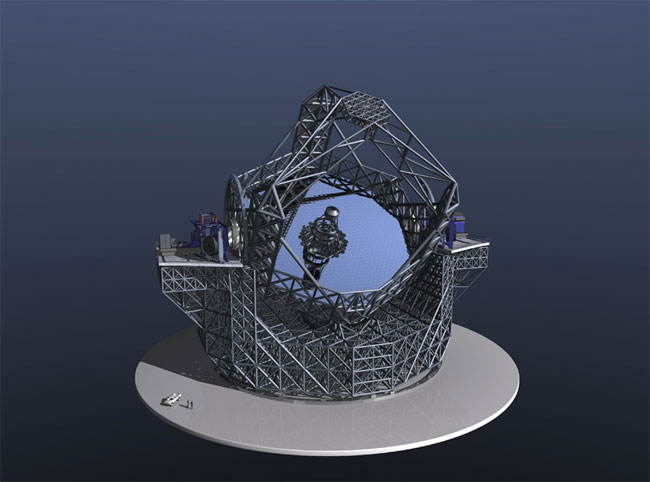
New telescopes expected to come online in the next decade could uncover clues about how the first galaxies formed, determine whether Earth-like planets are common around other stars and provide new insight into our solar system's murky history, scientists say.
Instruments such as the Atacama Large Millimeter Array (ALMA), the Expanded Very Large Array, the European Extremely Large Telescope and the Giant Segmented Mirror Telescope could answer these questions and raise new ones, scientists said at the "Astrophysics in the Next Decade" conference in Tucson, Arizona, last month.
The instrument many scientists are most excited about, however, is NASA's James Webb Space Telescope (JWST), hailed as the successor to Hubble and set to launch in 2013.
Together, these next-generation telescopes could open a window into a mysterious period of our universe's early history. Scientists currently have a good picture of the early universe about a million years after the Big Bang and about a billion years later, when the first galaxies appear.
"But we are missing some pages in this photo album in-between, and those are the most exciting pages of how the very first light formed in the very first galaxies," said Avi Loeb, a theorist at the Harvard-Smithsonian Center for Astrophysics.
Finding galactic building blocks
The new instruments should not only be able to glimpse these primordial galaxies, but also determine their chemical compositions and map the motions of their stars and gases. The JWST should theoretically be capable of peering back to a cosmic time before galaxies, when only their building blocks existed.
Get the Space.com Newsletter
Breaking space news, the latest updates on rocket launches, skywatching events and more!
This information could help reveal how galaxies are built. The current picture scientists have of galaxy formation is crude and incomplete, said Alan Dressler of the Carnegie Institution of Washington.
"There are big round balls of stars that we call ellipticals, and on the other end of the spectrum there are spiral galaxies like the one we live in," Dressler said. It was once thought ellipticals are made by merging two spiral galaxies together, but recent evidence suggests this is a very oversimplified picture.
"JWST will be the first glimpse at what these building blocks look like," Dressler said. "It will find them and make some measurements of the star formation rate. Then with ALMA, we'll be able to study the gas content of these building blocks, and finally with the 30-meter telescopes, we'll be able to understand how they're being assembled into galaxies."
Beyond galaxies
Next-gen telescopes could also help uncover new Earth-like planets orbiting distant stars.
"We have a very exciting opportunity in the next decade for exoplanets," said Sara Seager, a planet hunter at MIT.
The JWST could uncover Earth-like planets that pass in front of, or "transit," their parent stars. Current instruments such as NASA's Spitzer Space Telescope are best at spotting large gas giant transiting planets several times the size of Jupiter.
Because JWST will be more sensitive than Spitzer, it will be able to spot smaller planets, and also measure their atmospheric signatures, their temperatures and sizes, something that Spitzer has succeeded in doing for only a small number of exoplanets.
The new telescopes will also be a boon for solar system scientists, said David Jewett of the University of Hawaii, as they will allow for detailed studies of Kuiper Belt Objects, ancient remnants of the solar system's birth that lie in a ring beyond the orbit of Neptune.
"The JWST and ALMA will be sensitive to thermal radiation from Kuiper Belt Objects, so we can detect the heat from these things even though they're fantastically cold and fantastically far away," Jewett said.
The dream telescope
Asked what her "dream telescope" would be, Seager said she wanted a bigger, badder version of the Terrestrial Planet Finder, a NASA mission designed to detect Earth-sized planets but currently in limbo due to lack of funding.
Jewett voted for a monster general- purpose telescope that could be used to probe many different scientific questions. "We certainly don't know the next generation of questions that we need to ask," he said.
Others in the panel were content with what they already had. "It's not disingenuous to say that for some of us, the James Webb Space Telescope is the dream telescope," Dressler said.
- The Top 5 Telescopes of All Time
- Top 10 Most Intriguing Extrasolar Planets
- Top 10 Strangest Things in Space
Join our Space Forums to keep talking space on the latest missions, night sky and more! And if you have a news tip, correction or comment, let us know at: community@space.com.
Ker Than is a science writer and children's book author who joined Space.com as a Staff Writer from 2005 to 2007. Ker covered astronomy and human spaceflight while at Space.com, including space shuttle launches, and has authored three science books for kids about earthquakes, stars and black holes. Ker's work has also appeared in National Geographic, Nature News, New Scientist and Sky & Telescope, among others. He earned a bachelor's degree in biology from UC Irvine and a master's degree in science journalism from New York University. Ker is currently the Director of Science Communications at Stanford University.









